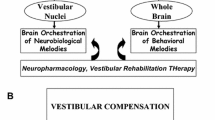Abstract
The technique of matrix analysis is used to compare the connectivity between vestibular neurons and oculomotor neurons of the two eyes that would generate a conjugate vestibulo-ocular reflex (VOR). The technique shows that the connectivity is normally anatomically symmetric. The technique is also used to determine the types and loci of adaptation within the VOR that will maintain conjugacy. Adaptation is divided into1) that evoked by changes in visual feedback, which requires VOR or system-specific changes and2) that produced by changes in the canals or muscles, which requires deficit-specific adaptation. In the former case, the adaptation could best be achieved by an additive alteration of the vestibularmotoneuron projections. In the latter case, the appropriate adaptations would be serial, multiplicative changes, applied at the level of the vestibular neurons when the canals are at fault or at the level of the motoneurons of the eye whose muscles are impaired. The analysis thus suggests multiple loci of plasticity within the VOR, specialized for adapting to different deficits.
Similar content being viewed by others
References
Abel LA, Schmidt D, Dell'Osso LF, Daroff RB (1978) Saccadic system plasticity in humans. Am Neurol 4:313–318
Blanks RHI, Curthoys IS, Markham CH (1975) Planar relationships of the semi-circular canals in man. Acta Oto-Laryngol 80:185–196
Collewijn H (1977) Optokinetic and vestibulo-ocular reflexes in dark-reared rabbits. Exp Brain Res 27:287–300
Collewijn H, Martins AJ, Steinman RM (1983) Compensatory eye movements during active and passive head movements: fast adaptation to changes in visual magnification. J Physiol 340:259–286
Gauthier GM, Robinson DA (1975) Adaptation of the human vestibulo-ocular reflex to magnifying lenses. Brain Res 92:331–335
Gonshor H, Melvill Jones G (1976) Short term adaptive changes in the human vestibulo-ocular reflex arc. J Physiol 256:361–379
Harris LR, Cynader M (1981) The eye movements of the darkreared cat. Exp Brain Res 44:44–56
Henson DB, Dharamshi BG (1982) Oculomotor adaptation to induced heterophoria and onisometropia. Invest Ophthalmol Vis Sci 22:234–240
Hess RF (1977) Eye movements and grating acuity in strabismic amblyopia. Ophthalmol Res 9:225–237
Ito M (1982) Cerebellar control of the vestbulo-ocular reflex around the flocculus hypothesis. Annu Rev Neurosci 5:275–296
Kommerell G, Olivier D, Theopold M (1976) Adaptive programming of phasic and tonic components in saccadic eye movements. Investigation in patients with abducens palsy. Invest Ophthalmol 15:657–660
Leigh RJ, Zee DS (1980) Eye movements of the blind. Invest Ophthalmol Vis Sci 13:328–331
Miles FA, Lisberger SG (1981) Plasticity in the vestibulo-ocular reflex: a new hypothesis. Annu Rev Neurosci 4:273–299
Optican LM (1982) Saccadic dysmetria In: Lennerstrand G, Zee DS, Keller E (eds) Functional basis of ocular motility disorders. Pergamon Press, Oxford, pp 441–451
Optican LM, Robinson DA (1980) Cerebellar dependent adaptive control of primate saccadic system. J Neurophysiol 44:1058–1075
Paige GD (1983) Vestibulo ocular reflex and its interactions with visual following mechanisms in the squirrel monkey. II. Response characteristics and plasticity following unilateral inactivation of horizontal canal. J Neurophysiol 49:152–168
Robinson DA (1976) Adaptive gain control of vestibuloocular reflex by the cerebellum. J Neurophysiol 39:954–969
Robinson DA (1982) The use of matrices in analyzing the threedimensional behaviour of the vestibulo-ocular reflex. Biol Cybern 46:53–66
Robinson DA (1985) The coordinates of neurons in the vestibuloocular reflex. In: Berthoz A, Melvill Jones J (eds) Adaptive mechanisms in gaze control. Facts and theories. Elsevier, Amsterdam, pp 297–311
Schor C, Hallmark W (1978) Slow control of eye position in strabismic amblyopia. Invest Ophthalmol Vis Sci 17:577–581
Schultheis LW, Robinson DA (1981) Directional plasticity of the vestibulo-ocular reflex in the cat. In: Cohen B (ed) Vestibular and oculomotor physiology. Am NY Acad Sci 374:504–512
Sherman KR, Keller EL (1986) Vestibulo-ocular reflexes of adventitiously and congenitally blind adults. Invest Ophthalmol Vis Sci 27:1154–1159
Snow R, Hore J, Vilis T (1985) Adaption of saccadic and vestibulo-ocular systems after extraocular muscle tenectomy. Invest Ophthalmol Vis Sci 26:924–931
Sparks DL, Mays LE, Gurski MR, Hickey TL (1986a) Long- and short-term monocular deprivation in the rhesus monkey: effects on visual fields and optokinetic nystagmus. J Neurosci 6:1771–1780
Sparks DL, Gurski MR, Mays LE, Hickey TL (1986b) Effects of Long-term and short-term monocular deprevation upon oculomotor function in the rhesus monkey. In: Keller EL, Zee PS (eds) Adaptive processes in visual and oculomotor systems. Pergamon Press, Oxford, pp 191–197
Srebro R (1983) Fixation of normal and amblyopic eyes. Arch Opthalmol 101:214–217
Uchino Y, Hirai H (1983) The vestibulo-ocular reflex arc in the newborn kitten. Exp Brain Res 53:29–35
Viirre E, Tweed D, Milner K, Vilis T (1986) A reexamination of the gain of the vestibulo-ocular reflex. J Neurophysiol 56:439–450
Viirre E, Cadera W, Vilis T (1987) The pattern of changes produced in the saccadic system and vestibulo-ocular reflex by visually patching one eye. J Neurophysiol 57:92–103
Viirre E, Cadera W, Vilis T (1988) Monocular adaptation of the saccadic system and vestibulo-ocular reflex. Invest Ophthalmol Vis Sci 29:139–147
Author information
Authors and Affiliations
Rights and permissions
About this article
Cite this article
Vilis, T., Tweed, D. A matrix analysis for a conjugate vestibulo-ocular reflex. Biol. Cybern. 59, 237–245 (1988). https://doi.org/10.1007/BF00332912
Received:
Published:
Issue Date:
DOI: https://doi.org/10.1007/BF00332912




